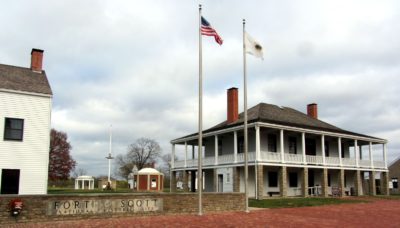The (Relatively) Unknown Treasures of the National Park Service
Our National Park System Consists of Far More Than Just National Parks
When most Americans think of the National Park Service, they contemplate the nation’s stellar collection of national parks: Yellowstone, Yosemite, the Everglades and the other 56 parks created by acts of Congress since 1872. But that’s only part of the story and holdings of the National Park Service, which celebrates its 100th birthday this week. The Park Service in fact manages and operates a total of 412 units, located in all 50 states and the District of Columbia. In addition to our iconic national parks, those holdings include battlefields and military parks, historical parks and sites, monuments, preserves, recreation areas, scenic trails and seashores. Some of these sites–like the White House–are well-known and heavily visited, although most Americans don’t realize they’re part of the national park system. Others are relatively obscure and infrequently toured by the public. But individually and collectively, they are all treasures and part of what makes the National Park Service’s holdings so special.
Congress first sparked the Park Service’s “mission creep” in 1906, when it passed the Antiquities Act. While creation of a new national park requires congressional action, the Antiquities Act authorizes the President to unilaterally proclaim and create “historic landmarks, historic and prehistoric structures, and other objects of historic or scientific interest” on lands owned or controlled by the United States as “national monuments.” Theodore Roosevelt, President when the Antiquities Act took effect and himself an ardent conservationist, wasted no time in exercising the sweeping authority Congress had granted him. In short order, Roosevelt designated as national monuments such treasures as Devil’s Tower in Wyoming, Chaco Canyon in New Mexico and–most controversially–the Grand Canyon in Arizona. Every subsequent president has similarly availed himself of the authority granted under the Antiquities Act and created additional national monuments by executive decree. Such monuments–all under the jurisdiction of the Park Service–now represent nearly one quarter of the units within the national park system.
But even aside from the Antiquities Act, Congress and the Executive Branch have over the past century added many other, diverse types of units to the national park system, all in the Park Service’s care. Some, like the national parks themselves, are areas with unique scenic and ecological attributes. Others, like Chaco Canyon, preserve and display the remnants of ancient cultures. Still others are the sites of key American accomplishments or (perhaps surprisingly) some of our nation’s darkest moments.
I was reminded of this last category of National Park Service assets during a road trip I took earlier this summer, when I toured the Central High School National Historic Site in Little Rock, Arkansas and Fort Scott National Historic Site in eastern Kansas. Both were profoundly moving and worthy of a visit.
Central High School National Historic Site

Central High School in Little Rock, Arkansas is the site of one of the most powerful and traumatic episodes of the Civil Rights Movement of the mid-20th century. Following the Supreme Court’s landmark 1954 decision declaring segregated schools to be unconstitutional, Little Rock’s school board quietly began efforts to desegregate its public school system. Nine African-American students–known today as the “Little Rock Nine”–were scheduled to enroll in Central High School in 1957. But those efforts were initially thwarted by Arkansas Governor and committed segregationist Orval Faubus, who called out the National Guard and ordered it to bar the Little Rock Nine from the school. Rioting ensued, and the African-American students were repeatedly vilified and brutalized by angry white mobs. Eventually, Republican President Dwight Eisenhower federalized the Arkansas National Guard and sent 1200 federal soldiers from the 101st Airborne Division to Little Rock. Federal troops wound up having to escort the black students to and from school for the entire 1957-58 school year.
This sad and shocking story is told exceedingly well and in vivid detail at the National Park Service-operated Central High School National Historic Site. (The Park Service Visitor Center is actually located across the street from Central High School because, 70 years later, the school continues to educate students, now fully integrated.) When I visited in July, the Visitor Center was empty. I had the entire place to myself, accompanied only by the engaging Park Service ranger who staffed the Center and proved to be a wealth of information even beyond the splendid exhibits on display.
Fort Scott National Historic Site
While my visit to Central High School was fully planned in advance, I confess that I stumbled upon the Fort Scott National Historic Site in easternmost Kansas. But Fort Scott was well worth exploring on a hot July afternoon when, again, the site was virtually deserted.
Fort Scott was built by the U.S. Army in 1842, in what is now the small Kansas community of the same name. Like Central High School would do a century later, Fort Scott bore witness to some of the most traumatic events of the mid-19th century.
Fort Scott was originally built as one of a series of military installations stretching from Minnesota to Louisiana following the infamous “Trail of Tears” of the 1830’s, when the federal government forcibly relocated Indian nations from their ancestral homelands in the Southeastern United States to an area west of the Mississippi River. That latter region was designated by the federal government as “Indian Country,” where dispossessed Native American tribes were guaranteed a new and permanent homeland, free from competing white settlements. Fort Scott, located hard by the Missouri-Kansas border, marked the border between Indian Country and the Missouri lands to the east that were available for white settlement. The fort, and the soldiers barracked there, were intended to segregate the two. But, as explained thoroughly at the Fort Scott National Historic Site, that federal pledge to the relocated tribes was soon broken by the government.

Two decades later, Fort Scott played an instrumental role in the Civil War, serving as a major supply depot for Union armies in the American West. The fort’s military stores made it an inviting target for Confederate troops, who in 1864 moved to capture Fort Scott and expand the Civil War theater onto the Great Plains. On October 25, 1864, vastly outnumbered Union cavalry troops defeated a large Confederate cavalry brigade in the Battle of Mine Creek, just north of Fort Scott, in what was one of the largest cavalry battles of the entire Civil War. That Union victory ended the Confederacy’s hopes of expanding the war onto the Plains.
I learned this story courtesy of another engaging Park Service ranger who patiently and in great detail recounted Fort Scott’s storied history, led me on a tour of the fort’s restored buildings, and directed me to a Civil War battlefield of which I was previously unaware but found profoundly moving.
The key point is that the America’s national park system consists of far more than simply 59 national parks. The system also includes a wide array of other cultural, military, natural and historical treasures that are similarly worthy of our appreciation, attention and visits. “America’s best idea” is truly a splendid and diverse array of unique national assets.
Reader Comments
One Reply to “The (Relatively) Unknown Treasures of the National Park Service”
Comments are closed.






Richard,
Thanks for this post — it’s interesting to see the connection in the NPS system between preservation of natural areas as well as those with cultural and historic significance.
The new designation of the Katahdin Woods and Waters NM today brings the total up to 413! In addition, to note — there are a number of newer NMs that are run by agencies other than the NPS, such as the BLM’s Grand-Staircase Escalante NM in Utah.